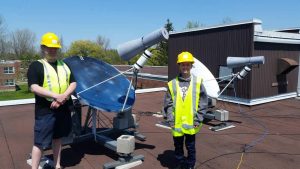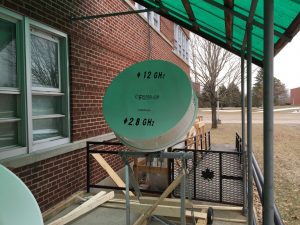2020 Open Day CCERA update available on video
The 2020 Open Day update presentation was captured at last minute on video and is available in 3 parts on YouTube.
Sorry about the sound quality.
CCERA completes first-pass of 21cm sky survey
We have had a busy summer with a new 21cm spectrometer instrument, producing a complete sky map
covering declinations from -35 to +70, across the -160km/sec to +160km/sec redshift range.
We have a “first view” total brightness map from that survey–expect more data and different maps soon!

CCERA hosts visit from Canada Wide Science Fair participant
Jarek Osika, a 14-year-old participant in the Canada Wide Science Fair visited the CCERA
facilities on May 16th, during the science fair.
We showed him around the facilities, and sent a CCERA hat and bumper stickers with him.
Jarek went on to win the Excellence in Astronomy award, sponsored by the Royal Astronomical Society of Canada for his project Exploring 1420 MHz. Jarek designed and built a small 21cm radio telescope for the project, and we’re happy to have inspired his work. Congratulations, Jarek!
Jarek and his family are from Flin Flon Manitoba, and in the future, we hope to collaborate with the local schools there as part of their emerging STEM program.
CCERA nears completion of first “school” radio telescope
We have been busy the last few weeks building-up a mobile radio telescope in support of high-school physics programs.
CCERA secured access to a number of small, very-high-quality microwave dishes, and we’re turning two of those into a mobile radio telescope that can be loaned to local high-schools for radio astronomy demonstrations and short-term observing programs.
Based on an Andrew 0.8M reflector, these telescopes are designed to receive signals at 12GHz or 2.8GHz, depending on the observing program.
New back-end for dual-channel 21cm spectrometer
We’ve upgraded the back-end of the 21cm spectrometer, including both DSP software and the matching SDR hardware.
The SDR receivers are now synchronized to a GPS-derived 10MHz reference clock, which provides an uncertainty in doppler measurements of approximately 30cm/sec.
The FFT resolution has been improved, by covering only the +/- 200km/sec of doppler velocity that is “visible” within the galaxy. This provides a resolution in the FFT of approximately 0.26km/sec or approximately 0.1% of the peak velocity that we are able to observe within the galaxy.
Further DSP work will allow us to double the resolution (half the doppler velocity) in the coming weeks. Stay tuned for updates.
CCERA and Carleton University begin collaboration
CCERA and the Physics department at Carleton University have begun a collaborative effort in support of their undergraduate astrophysics program.
In this program, 3rd-year astrophysics students will gain remote access to CCERA’s instrumentation and data-feeds in support of a lab-based radio astronomy segment in the 3rd-year astrophysics program.
The program is coordinated for Carleton University by Etienne Rollin and Penka Matanska, both instructors in the physics department at Carleton.
First of two 21cm “binocular” dishes brought on-line
The first of two 1.2m dishes for rapid surveys of the 21cm line has been brought on-line, and is currently observing at the declination of the galactic center (declination of -29 degrees).

The second dish will be brought on-line soon, which will allow spectral surveys do be completed at twice the rate of a single dish of the same size.
Stay “tuned” for more announcements….
Successful observations of Cassiopeia A
We’ve been waiting patiently for Cassiopeia A to move far enough away from the Sun (back towards nighttime) to make observations feasible. In the last few days, we’ve been able to capture very high-quality transits, as shown below.

A donated 12ft Andrew Dish!
John Blais, of Almonte, Ontario, very kindly donated a 12ft Andrew solid-aluminum dish to us. The long-term plan is to incorporate it into our pulsar work.
Here it is in the truck, ready to go off to the lab:

We’ll make up a very-simple fixed-pointing mount, which will have the dish pointed nearly-vertical, with a 9 degree tilt to the North.


